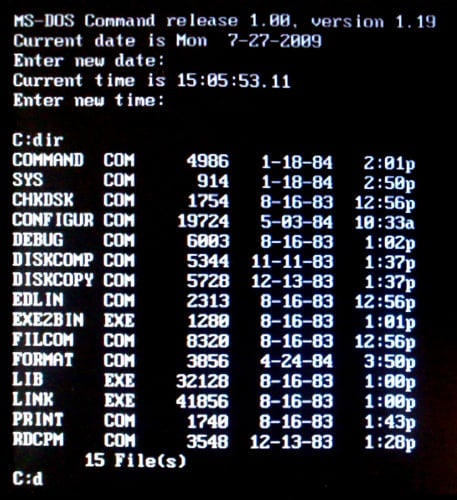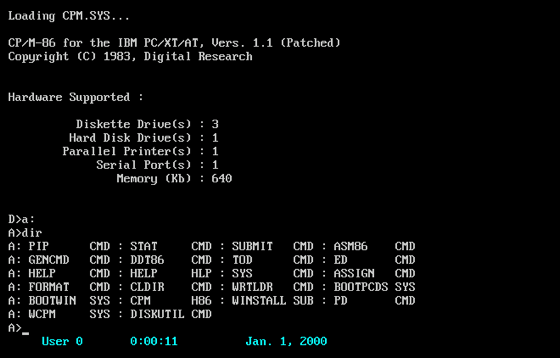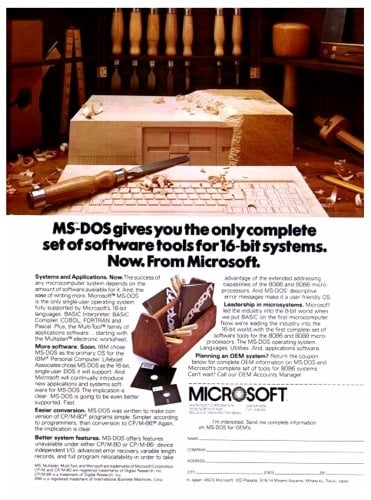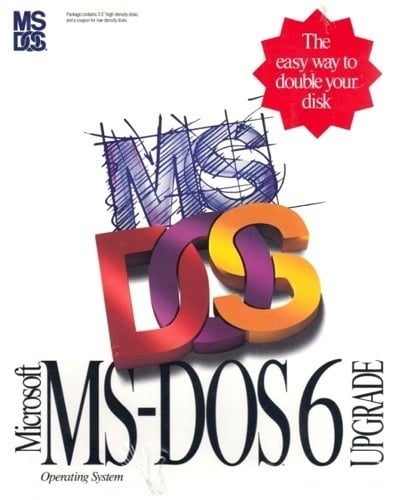
Command line: MS-DOS 1.19 still running after all these years
Posted on 07/27/2011 8:42:18 AM PDT by ShadowAce
MS-DOS is 30 years old today. Well, kind of. On 27 July 1981, Microsoft gave the name MS-DOS to the disk operating system it acquired on that day from Seattle Computer Products (SCP), a hardware company owned and run by a fellow called Rod Brock.
SCP developed what it at various times called QDOS and 86-DOS to run on a CPU card it had built based on Intel's 8086 processor.

Command line: MS-DOS 1.19 still running after all these years
The company had planned to use Digital Research's CP/M-86 operating system, then still in development. But, having released the card in November 1979 - it shipped with an 8086-compatible version Microsoft's Basic language interpreter-cum-operating system - and reached April 1980 without CP/M-86 becoming available to bundle, SCP decided it had to create its own OS for the card.
Enter, in August 1980, QDOS. It really did stand for Quick and Dirty Operating System. That's actually what it was: a basic but serviceable OS good for coding and running programs written in 8086 assembly language - the x86 instruction set. It was written by SCP's Tim Paterson, who had joined the company as a programmer a couple of years previously and began work on it in April 1980.

On the cards: Seattle Computer Products advertises its wares
Some observers later claimed that QDOS too closely resembled CP/M for comfort. Paterson himself would later say that QDOS' design criteria specifically included the abililty to support programs written for CP/M and compiled for the 8086. That's not at all surprising given that SCP undoubtedly saw QDOS as a temporary stand in until Digital Research (DR) shipped CP/M-86.
The picture we have today is muddied by the claims that IBM originally wanted to use CP/M-86 in its first personal computer. IBM and DR famously failed to come to terms that would allow CP/M-86 to be bundled with the PC, and IBM turned to Microsoft for an alternative. Digital Research founder Gary Kildall, who died in 1994, would later allege that Microsoft's product was a rip off, fuelling plagiarism claims that Paterson has always denied - he reverse engineered it.

The competition: CP/M-86 in action
Source: Wikipedia
Update My fellow Reg hack Andrew Orlowski points out that, no matter what Paterson says, the US court ruled against the programmer in a defamation lawsuit he brought against publisher Little Brown for claiming the origins of QDOS were not clear-cut.
Back in 1980, Paterson continued to evolve QDOS through the year, the OS being renamed 86-DOS - it was now evidently no longer viewed as a rough-and-ready stand-in - between September and December 1980. Accounts differ as to when the name - and the OS' status - was switched, but December is the date Paterson himself gave during a Softtalk interview published just a few years later.
It's at this point that Microsoft re-enters the picture, acquiring from SCP a licence to market and sell 86-DOS, paying $25,000 for the privilege. Microsoft was now working with IBM in place of DR - the two had been partners since November 1980 - to supply the operating system for the hardware giant's first personal computer, but it kept IBM's identity hidden from SCP and Paterson until it acquired the OS in its entirety the following year.
"We all had our suspicions that it was IBM that Microsoft was dealing with," Paterson would later say, "but we didn't know for sure."

Microsoft would later advertise MS-DOS' claimed superiority to CP/M-86
Microsoft had been in contact with SCP ever since the latter asked to use its Basic, so it would have been aware of SCP's work on QDOS, the operating system's design goals and its convenient compatibility with CP/M-86. Microsoft would have seen how closely QDOS matched the product it had been commissioned to supply to IBM, and its ties with SCP would have helped it gain that initial re-distribution licence.
You can read a copy of the 86-DOS Programmer's Manual (PDF) here.
By July 1981, Microsoft had sufficient understanding of IBM's plans - and the vision to conceive of what the personal computer market might become - to consider not merely licensing 86-DOS but buying it outright from SCP, for a further $50,000 - $75,000 in total, $180,000 (£112,000) in today's money. SCP was allowed to continue to offer the OS with its own hardware. Paterson had already quit SCP, in April 1981, to join Microsoft the following month.
"So on 27 July, 1981, the operating system became Microsoft's property," Paterson said in the 1983 Softtalk interview. "According to the deal, Seattle Computer can still see the source code, but is otherwise just another licensee. I think both companies were real happy. The deal was closed just a few weeks before the PC was announced. Microsoft was quite confident."
In August 1981, Big Blue introduced what would eventually become known as the IBM PC, though it was originally the 5150. It was based on the Intel 8088 CPU, a lesser - but cheaper - version than the 8086 that used an 8-bit external bus rather than the 16-bit bus found on the 8086.
Paterson came with his operating system, and stayed with Microsoft for a year while 86-DOS was honed into MS-DOS 1.0, released as a standalone product early in 1982. He left in March 1982, after the completion of MS-DOS 1.25, but would later return (twice) to Microsoft, where he would go on to work on Visual Basic. He eventually formed his own hardware company, Paterson Technology, though his blog now lists his status as retired.
Now 55, Paterson continues to blog about the QDOS' development, emphasising the reasons for its CP/M friendliness yet stressing its under-the-hood differences.
From July 1981, SCP continued to sell the operating system it had created, now calling it Seattle DOS and bundling it with its hardware products. It continued to do so until 1985, by which time its was clear buyers wanted systems, and cheap ones - whether from IBM or the many 'cloners' who'd released products compatible with its technology.
Brock now sought to sell his rights to MS-DOS, a scheme with which Microsoft was not best pleased and said its agreement with SCP did not permit. Brock sued, and the case went to trial in the last few months of 1986. Brock and Microsoft quickly came to an out-of-court arrangement, however: Brock sold his licence to Microsoft for $925,000, leaving the software giant in complete ownership of the OS.
Through this time, Microsoft was releasing version after version of MS-DOS, each mirrored by a release of IBM's IBM-DOS and, later, PC-DOS, as its take on the OS came to be called.
Other versions appeared, tweaked by PC manufacturers using Microsoft's OEM kit to more closely fit the specifics of their hardware. Many would run software developed for the IBM PC, others would not, though they would run generic MS-DOS-compatible applications.
CP/M-86 was eventually released, in 1981, and subsequently offered by DR as a third-party alternative to MS-DOS. As you can see from the ad above, Microsoft saw it as as a threat. DR's OS was bundled with a number of IBM PC rivals, from the likes of Apricot and Siemens.
You can view the source code for CP/M-86 - and other versions of the OS - here.
In May 1988, CP/M-86 was effectively re-released as DR-DOS and pitched more directly as an alternative to MS-DOS itself than to IBM's PC-DOS.
DR-DOS found many supporters but failed to dent Microsoft's market share. Microsoft quickly established the technique of announcing new MS-DOS features well ahead of their appearance, previously seen as an approach that could only kill sales of the current version. Instead, it kept buyers away from rival offerings, and it's now a common tactic employed by highly competitive tech companies.

MS-DOS gets upgraded, kind of
Meantime, MS-DOS continued to evolve, gaining a graphical user interface of sorts with version 4.0, disk compression tech with version 6.0, and FAT32 support with version 7.1.
Version 4.0 should have been the final release - even Microsoft said so, announcing in 1987 that "DOS is dead" and that we should all be using OS/2, jointly developed by IBM and Microsoft, though the latter stepped away from it when Windows 3.0 became a huge success. That's another story.
Microsoft's work on DOS eventually took the OS to version 8.0, the release used for Windows XP boot discs. With that release, on 14 September 2000, MS-DOS development formally came to an end, though significant work stopped some years earlier with MS-DOS 5.0 when it ceased to be offered as a standalone product. ®

I love the command line. Everything went downhill when people started depending on GUIs.
I spend every day admin’ing systems from only the command line.
I loved programming machine language by flipping the switches on the front - writing actual code is for sissies. /Just Kidding
Ping list for the discussion of the politics and social (and sometimes nostalgic) aspects that directly effects Generation Reagan / Generation-X (Those born from 1965-1981) including all the spending previous generations are doing that Gen-X and Y will end up paying for.
Freep mail me to be added or dropped. See my home page for details and previous articles.
Loves my Xemacs though.
When I started coding, we had to code in 0s and 1s, and sometimes we didn't even have the 1s.
vim works for me. :)
The command line and scripts are the ultimate method for admins to work.
I still say OS2/Warp was the best PC operating system, ever.
I have one VM set up for DOS with networking and it can be kind of hard for me to keep up with where everything is.
Having said that I still miss the good old command line only days.
Yep... fancy GUIs look nice but automation is a lot easier if you also have a command line interface.
I’ve written quite a number of Elisp customizations for
Xemacs and have beggged, borrowed or stolen countless others.
I guess you can do much the same thing in vi, vim, gvim etc.
(kinda, sorta, don’t really know) but some of these add-ons
are absolutely must haves for me. Wouldn’t know what to do
without ‘em.
Touché!
We were an OS2/Warp company for the longest time.
Every enduser totally hated it.

VMS is my nominee as the best OS of all time. Too bad
you need VAX or Alpha processors to run it.
Disclaimer: Opinions posted on Free Republic are those of the individual posters and do not necessarily represent the opinion of Free Republic or its management. All materials posted herein are protected by copyright law and the exemption for fair use of copyrighted works.